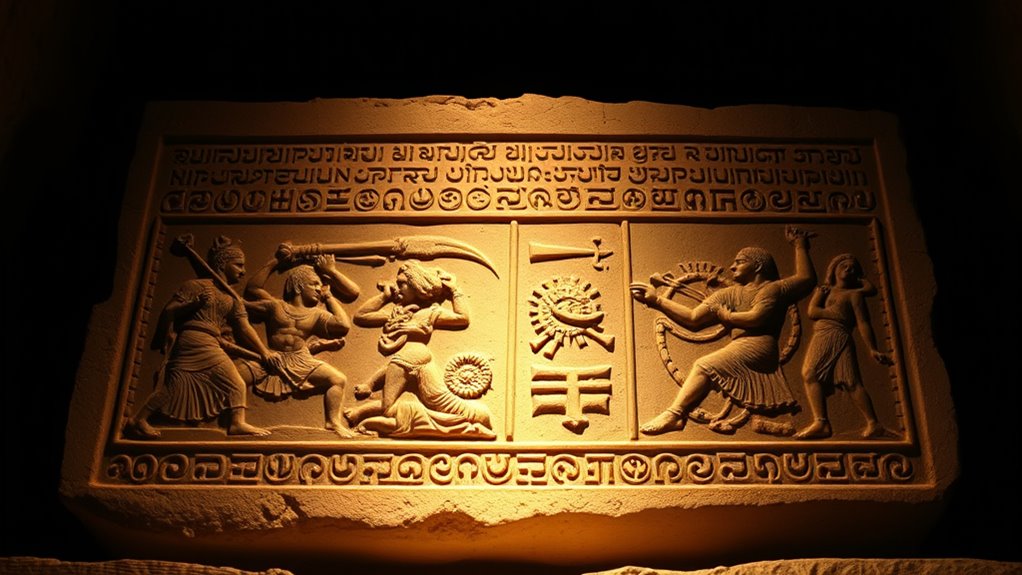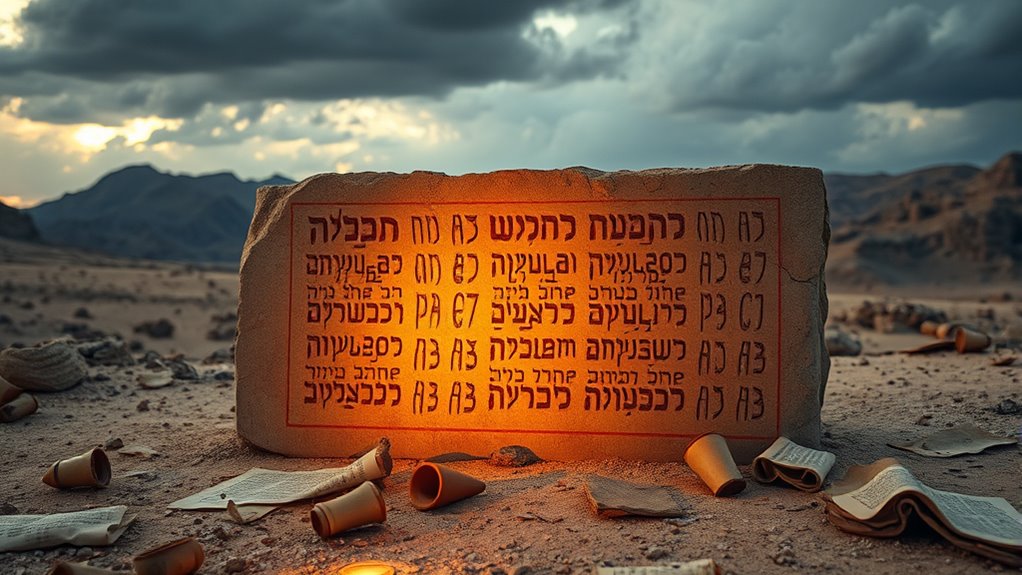God commanded violence in the Old Testament to serve divine purposes rooted in justice, holiness, and moral growth within a specific cultural and historical context. Warfare often reflected societal norms of ancient Near Eastern cultures, with commands designed to maintain moral order, protect the chosen community, and test their faith. These actions also demonstrated God’s authority and mercy, warning before judgment. Exploring this further reveals how God’s approach to justice evolved over time and its relevance today.
Key Takeaways
- Divine commands reflected societal norms and rituals of ancient cultures to promote moral order and spiritual purity.
- Violence was used as a form of divine justice to eradicate evil, idolatry, and moral decay.
- Commands aimed to establish a holy nation by removing corrupt influences and safeguarding divine holiness.
- God’s mercy often preceded judgment, emphasizing patience and warnings before executing divine discipline.
- These directives were contextually rooted in cultural and religious practices, illustrating God’s sovereignty and moral justice.
Historical Context of Ancient Near Eastern Warfare

Understanding the historical background of ancient Near Eastern warfare is essential to grasp why violence appears frequently in the Old Testament. During this period, warfare was deeply intertwined with cultural conflicts and religious practices. Ancient rituals often justified violence, portraying it as a divine duty or a means to appease gods. Societies fought over land, resources, and religious supremacy, making warfare a common aspect of daily life. These conflicts shaped the narratives in the Old Testament, where battles reflected broader cultural struggles. Recognizing this context helps you see that violence wasn’t random but rooted in the worldview of these ancient communities, where warfare and religious rituals reinforced social cohesion and divine authority. In addition, the use of ritualistic violence was often integrated into religious ceremonies, further blurring the lines between warfare and spiritual practices. This integration of violence with spiritual beliefs was a common practice in many ancient societies, influencing how divine commands were interpreted and executed. Moreover, the concept of divine justice was frequently invoked to legitimize violent acts, aligning them with divine will and moral righteousness. Additionally, understanding these practices reveals how religious authority was often used to justify acts of violence, solidifying its role in maintaining social order.
The Role of Justice and Divine Righteousness

The concept of justice and divine righteousness is central to understanding why God commanded violence in the Old Covenant. You face moral dilemmas where divine justice takes precedence, often balancing mercy with strict judgment. God’s actions reflect His commitment to righteousness, ensuring that evil is ultimately addressed. This aligns with the biblical principle that divine justice sometimes necessitates protecting societal order through strict measures. Recognizing the importance of essential oils for justice can help deepen the understanding of divine actions and moral order. Additionally, recent AI discoveries demonstrate how new laws of physics can be uncovered through experimentation, highlighting the importance of justice in scientific progress.
The Concept of Holiness and Separation

You recognize that God’s name is sacred and must be treated with utmost respect. This sense of holiness calls for maintaining purity and moral distinction in how His followers live. Understanding this separation helps explain why certain actions, including violence, were commanded to preserve God’s holiness. Additionally, the concept of sound healing science reflects how specific practices were used historically to promote spiritual and physical well-being in alignment with divine principles. The importance of spiritual boundaries underscores the need to differentiate between the divine and human realms to uphold the sacredness of God’s commandments. Moreover, the Personality Test studies can offer insights into individual dispositions that influence perceptions of divine commands and moral boundaries. Recognizing that AI vulnerabilities exist in modern technology reminds us of the importance of maintaining moral integrity and vigilance in applying divine principles across different contexts. This understanding of sacred separation also emphasizes the significance of moral clarity in interpreting divine directives and ensuring their proper context and purpose.
Sacredness of God’s Name
God’s name is considered sacred because it embodies His holiness and separates Him from all creation. You’re meant to treat it with utmost reverence, recognizing divine authority behind every utterance. This sacredness underscores the need for respect and deliberate speech when mentioning God. To understand this, picture:
- A reverent hush during divine ceremonies
- The careful avoidance of misusing His name
- The use of special words to address Him respectfully
- The acknowledgment of His sacredness in all aspects of life
- Recognizing the divine authority behind God’s name further emphasizes the importance of respectful language and conduct, reinforcing the need for reverent speech in all interactions involving the divine. Additionally, understanding the concept of holiness helps believers grasp why God’s name must be treated with such honor and care. This understanding is rooted in the recognition of His holiness and separation, which sets Him apart from all creation and emphasizes the sacredness of His name.
Purity and Moral Distinction
Understanding purity and moral distinction is essential because they define what sets God’s nature apart from everything else. In ancient cultures, practices around ritual purity reflected a commitment to holiness and separation from impurity. These cultural practices emphasized that certain actions, foods, and behaviors could defile a person, distancing them from divine standards. By maintaining ritual purity, people demonstrated their dedication to God’s moral standards and their desire to be morally distinct from surrounding nations. This separation reinforced the idea that God’s holiness requires His followers to be pure and set apart. Such distinctions weren’t just social or cultural; they symbolized a deeper spiritual truth—that holiness involves moral and ritual separation, preserving the integrity of God’s divine nature in His people. Additionally, digital literacy programs have helped many seniors understand and respect these distinctions in contemporary contexts, highlighting how cultural practices can carry spiritual significance across different eras.
The Canaanite Conquest and Moral Testing

The conquest of Canaan presents a complex moral challenge, as it involves commands to destroy entire populations, including women and children. These actions reflect the cultural practices and ancient rituals of the time, which often involved severe rites and sacrifices. Understanding this context helps clarify God’s instructions, not as acts of cruelty, but as a moral test for the Israelites. You might picture:
- The elimination of corrupt cultural practices
- The eradication of idolatrous rituals
- God’s judgment on widespread moral decay
- The preservation of a holy nation
These commands aimed to prevent the Israelites from adopting harmful practices and to establish a moral boundary. The conquest tested faith and obedience, shaping a community committed to divine standards amid a morally compromised society.
God’s Mercy and Judgment in the Old Testament

You’ll see that God’s actions in the Old testament reflect a balance between justice and mercy. To understand this, you need to regard the context of ancient warfare and the divine sovereignty behind these commands. Recognizing these aspects helps clarify how God’s judgment and mercy work together in His divine plan. Considering retirement planning principles can also provide insight into God’s strategic use of discipline and mercy within His overarching plan. Additionally, understanding cultural practices of the time can shed light on the reasons behind specific divine commands. For example, examining cultural celebrations and their significance reveals how divine commands were intertwined with societal norms and spiritual practices. Incorporating predictive modeling insights from educational data mining can help us better comprehend the patterns in divine actions and their purpose. Moreover, understanding the Vetted – Flat Iron Bike options demonstrates how structured systems can be designed to balance performance and reliability, much like how divine commands balance justice with mercy.
Balancing Justice and Mercy
Balancing justice and mercy in the Old Testament reveals how God demonstrates both righteous judgment and compassionate care. You see that God’s actions reflect a deep awareness of cultural differences and the demands of modern ethics. He executes justice to uphold righteousness while offering mercy to guide His people toward repentance. This balance shows that divine judgment isn’t arbitrary but rooted in love and the desire for reconciliation. To envision this, consider:
- God’s patience in giving warnings before judgment
- His mercy in offering forgiveness to the repentant
- The importance of justice in maintaining social order
- The cultural context that shapes how justice and mercy are expressed
This harmony reminds you that divine commands aren’t contradictory but part of a divine plan to foster righteousness and compassion simultaneously. Understanding the divine balance can help you appreciate how God’s justice and mercy work together in perfect harmony, especially when considering the cultural context that influences Old Testament narratives.
Context of Ancient Warfare
Understanding the context of ancient warfare helps clarify how God’s commands in the Old covenant reflect both judgment and mercy. During that time, warfare often involved tribal customs and ancient rituals that shaped how nations fought and interacted. These customs could include practices like sacred wars or rituals meant to purify or dedicate battles to divine purposes. Recognizing this, God’s commands aligned with the tribal mindset, emphasizing justice against widespread corruption and idolatry. At the same time, His mercy emerges in His patience and warnings before judgment. By understanding these cultural factors, you see how God’s directives were rooted in the norms of ancient societies, aiming to bring about moral order while demonstrating mercy in His long-suffering patience.
Divine Sovereignty Display
God’s sovereignty is vividly displayed in the Old Scriptures through both acts of mercy and judgments that reveal His authority over all creation. Prophetic symbolism often points to divine sovereignty, illustrating how God’s mercy offers hope, while His judgment demonstrates His power to uphold justice. You see this in stories where God spares the faithful, showing mercy, or brings judgment to the wicked, affirming His control. These acts serve as a testament to His divine sovereignty, reminding you that God’s authority extends over nations and individuals alike.
- Mercy offered through prophetic symbols of hope
- Judgment as a display of divine sovereignty
- Prophetic symbolism revealing God’s ultimate authority
- Mercy and judgment both affirm His sovereignty in history
The Development of Moral Understanding Over Time

Over time, humanity’s moral understanding has evolved considerably, shaping how you interpret actions deemed acceptable or wrong. This process reflects moral development and ethical evolution, as societies learn from experience and reflection. In ancient times, actions like violence or conquest were often accepted as justified within their cultural context. Today, you see morality through a different lens, emphasizing compassion and justice. This shift shows that moral understanding isn’t static but grows with human awareness. Recognizing this helps you appreciate why divine commands in the Old *testament* might have aligned with the moral standards of that time. It also highlights how moral development influences religious interpretation, encouraging you to see biblical actions within their historical and cultural context.
The Purpose of Divine Commands and Human Agency

As you consider the moral development reflected in biblical times, it’s important to recognize that divine commands served specific purposes within their historical context. These commands aimed to guide human behavior, promote justice, and establish societal order. They also highlight the role of human agency and free will, emphasizing that individuals are responsible for their choices.
The divine commands:
- Provided moral boundaries during early societal development
- Encouraged obedience and trust in God’s plan
- Enabled humans to exercise free will responsibly
- Fostered moral growth over time through accountability
Interpreting Violence in Light of Biblical Theology

Interpreting violence in biblical theology requires understanding the broader narrative and the divine purpose behind such actions. You need to recognize that many biblical stories reflect cultural rituals and mythological narratives common in ancient Near Eastern societies. These stories often depict divine-human interactions within a framework that shaped cultural identity and religious beliefs. When you analyze these violent commands, consider how they serve to establish God’s covenant, uphold justice, or demonstrate His sovereignty rather than endorse violence as an ideal. Biblical violence isn’t isolated but embedded within a divine plan that reveals God’s justice, mercy, and purpose for humanity. By interpreting these acts through biblical theology, you see how they fit into God’s overarching story of redemption and divine justice.
Frequently Asked Questions
How Do Different Christian Denominations Interpret Old Testament Violence?
When you explore how different Christian denominations interpret Old Testament violence, you see they approach scriptural interpretation differently. Some see it as moral dilemmas reflecting historical contexts, emphasizing God’s justice. Others view it symbolically or as part of divine discipline. You might find that these varied perspectives help believers reconcile difficult passages, shaping their understanding of God’s nature and moral expectations within their faith traditions.
What Are the Theological Implications of Divine Violence?
You might think divine violence challenges moral consistency, but it actually highlights divine justice’s complexity. When you examine divine violence, it prompts you to wrestle with how God’s actions reflect moral standards. Ironically, it shows that divine justice isn’t always gentle, urging you to accept that God’s ways transcend human understanding. This deepens your appreciation for God’s moral consistency, even amid actions that seem harsh by human standards.
Is Old Testament Violence Compatible With New Testament Teachings?
You might wonder if Old Testament violence aligns with New Testament teachings. While the two seem different, they both reflect God’s pursuit of divine justice. You face moral dilemmas when considering God’s actions, but understanding His justice helps reconcile these differences. God’s methods evolve to reveal His mercy and love in the New Testament, yet His pursuit of justice remains consistent, showing that both covenants are part of His divine plan.
How Do Scholars Reconcile God’s Love With Commands for Violence?
Think of it as a tightrope walk between divine justice and mercy. Scholars see God’s commands for violence as part of moral paradoxes, where divine justice balances love. They argue that God’s actions reflect a larger plan to uphold righteousness and justice, even when it’s hard to reconcile with His love. This perspective helps you understand that God’s justice isn’t separate from His compassion but intertwined in a divine tapestry.
What Is the Role of Human Free Will in Divine Commands?
You play a key role in moral responsibility, even within divine sovereignty. When God issues commands, you’re given free will to choose obedience or disobedience. This free will allows you to act morally or immorally, making you accountable for your choices. Divine sovereignty guides but doesn’t eliminate your moral responsibility. Your ability to choose shapes the relationship between divine commands and human actions, highlighting the importance of free will in God’s moral framework.
Conclusion
You might wonder why God commanded violence, but remember, His actions aimed to establish justice and holiness in a chaotic world. It’s easy to judge from today’s perspective, yet back then, those commands served a higher purpose—testing faith and removing evil. By understanding the historical context and divine intentions, you see that God’s justice was also a form of mercy, guiding His people toward righteousness even through difficult commands.










